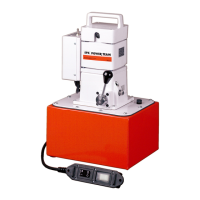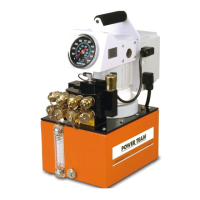Operating Instructions Form No. 102875
SAFETY PRECAUTIONS (GENERAL) CONTINUED -
• High pressure fluid is present throughout a hydraulic system. Always use caution when operating,
repairing, or maintaining this equipment. Before beginning any work on any hydraulic system
component, stop the equipment, disconnect from its power source, and relieve all pressure in all parts
of the system. Do not tamper with the internal hydraulic relief valve settings.
• Avoid exposing hydraulic equipment (especially hoses) to extreme high or low temperatures. Damage
to equipment or failure may result and cause loss of control or injury to the operator.
• Exercise caution to avoid the risk of fire.
• Do not drop any hydraulic system components. Damage to the equipment and/or injury may result.
• Avoid slipping or falling by cleaning up any oil spills.
• Avoid back injury by always lifting equipment carefully.
• It is strongly recommended to view the Power Team Hydraulic Safety video tape before using hydraulic
equipment.
POWER SUPPLY
Electric
Electrical Shock or Electrocution
• Any electrical work must be done and tested by a qualified electrician per local directives and
standards.
• Disconnect the pump from the power supply and relieve pressure before removing the motor case
cover or performing maintenance or repair.
• Never use an ungrounded power supply with this unit.
• If the power cord is damaged or wiring is exposed, replace or repair immediately.
• Changing the voltage on this unit is an involved, and if improperly performed, hazardous procedure.
Consult the manufacturer for specific information before attempting any rewiring.
• All PE55 Series pump motors must be wired for clockwise (CW) rotation when viewed from the lead end
(top) of the motor. PE8 Series, PE17 Series, PE30 Series, PR10 Series, and PE46 Series pump motors
must be wired for counterclockwise (CCW) rotation when viewed from the lead end (top) of the motor.
• Check the
total
amperage draw for the electrical circuit you will be using. (For example: Do not plug a
pump or pumps that may draw 25 amps into a 20 amp fused electrical circuit.)
• Do not attempt to increase the powerline capacity by replacing a fuse with another fuse of higher value.
Overheating of the powerline and the possibility of a fire will result.
• To rewire a motor from one voltage to another or when a flow control valve is changed between manual
and solenoid, consult the electrical schematic in the pump's parts list.
• Electric pumps should never be exposed to rain or water which could cause personal electrical hazard.
• Avoid conditions which can cause damage to the power cord such as abrasion, crushing, sharp cutting
edges, or corrosive environment. Damage to the power cord can cause an electrical hazard.
Gasoline Engine
No Smoking No Open Flame Flammable
• Read the instruction manual for the gasoline engine before using for correct operating procedure.
• Turn off the engine and relieve pressure when not in use or when working on any part of the system.
• Proper ventilation is critical during refueling.
• Do not allow fuel to splash on the engine when refueling.
• Do not add fuel when the engine is running or hot.
Sheet No. 2 of 8
Rev 10 Date: 02 Mar 2005

